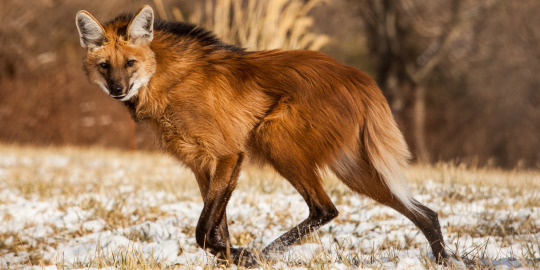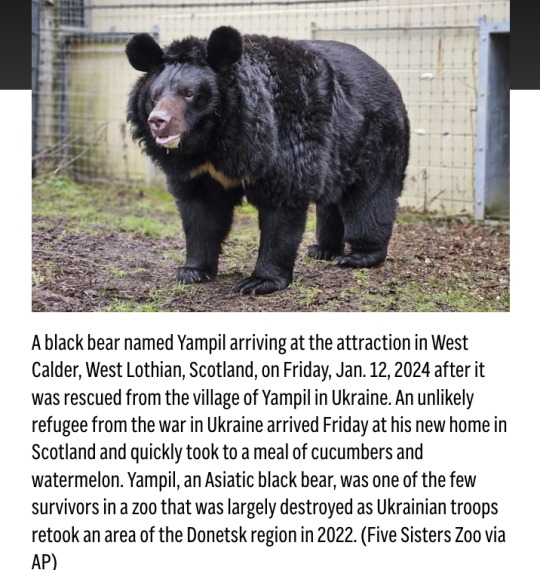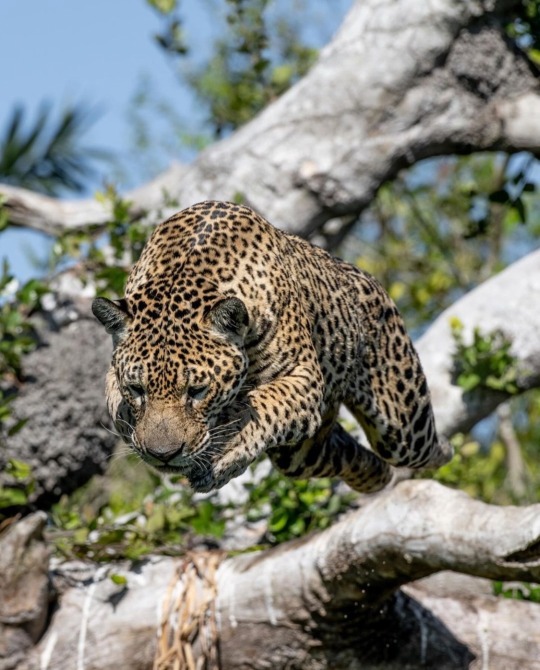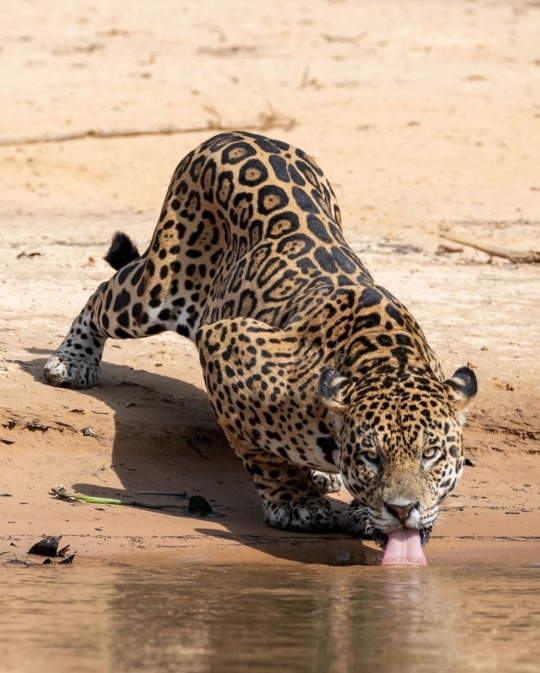#Threatened species
Text






Maned Wolf photodump! Learn more about them here <3
#eee theyre so cool#I’d kinsider them if they weren’t so solitary#in fact I might anyways#maned wolf#endangered animals#threatened species#cool animal things#wolfkin#therian#foxkin#canine#maned fox
1K notes
·
View notes
Text


By Brian Melley, AP News
13 January 2024
LONDON (AP) — An unlikely refugee from the war in Ukraine — a rare Asiatic black bear — arrived at his new home in Scotland on Friday and quickly took to a meal of cucumbers and watermelon.
The 12-year-old Yampil was named for a village in the Donetsk region where he was one of the few survivors found by Ukrainian troops in the remains of a bombed-out private zoo.
Yampil, who had previously been called Borya, was discovered by soldiers who recaptured the devastated city of Lyman during the Kharkiv counteroffensive in the fall of 2022, said Yegor Yakovlev of Save Wild, who was among the first of many people who led the bear to a new life.
The bear was found in a menagerie that had long been abandoned by its owners.
Almost all the other animals had died of hunger, thirst or were struck by bullets or shrapnel and some were eaten by Russian troops.
Yampil narrowly missed the same fate, suffering a concussion from a projectile that landed nearby.
“The bear miraculously survived,” said Yakovlev, also director of the White Rock Bear Shelter, where the bear recovered.
“Our fighters did not know what to do with him, so they started looking for rescue.”
What followed was an odyssey that your average bear rarely makes, as he was moved to Kyiv for veterinary care and rehab, then shipped to a zoo in Poland, then to an animal rescue in Belgium, where he spent the past seven months, before landing in the United Kingdom.
Brian Curran, owner of Five Sisters Zoo in West Calder, Scotland, said his heart broke when he learned of the plight of the threatened Asiatic black bear.
“He was in terrible condition; five more days and they wouldn’t have been able to save him,” Curran said. “We were just so amazed he was still alive and well.”
The bear was skinny but not malnourished when he was found, said Frederik Thoelen, a biologist at the Nature Help Center in Belgium.
He now is estimated to weigh a healthy 440 pounds (200 kilograms), Thoelen said.
The nature center in Belgium, which usually treats injured wildlife and returns them to their natural settings, has taken several animals rescued from the war in Ukraine, including a wolf, a caracal cat and four lions, though those animals had not experienced the ordeal Yampil endured.
It was remarkable how calm Yampil was when he arrived in Belgium, Thoelen said.
The bear was trained in the past two weeks to move from his enclosure to the crate that would transport him across Belgium to Calais, France, then across the English Channel on a ferry to Scotland.
Pastries from a local bakery were used for good measure to lure him Thursday into the cage, where he was sedated for the journey.
“We want to use the food that he likes most, and for most bears — and for people also — it’s sweet, unhealthy foods,” Thoelen said.
Thoelen had a sense of the bear’s weight as he drove the crate to the port.
“Every time when we had a red light or a traffic jam, when the bear moved a little bit, you could feel the van moving also,” he said.
“You could feel it was a heavy animal in the back of the car.”
Yampil arrived at the zoo about 15 miles (25 kilometers) west of Edinburgh and immediately made himself at home.
He feasted on cukes — said to be his favorite food — and melon, said Adam Welsh, who works at Five Sisters.
The Asiatic black bear is listed on the International Union for Conservation of Nature’s Red List of Threatened Species as vulnerable to extinction in the wild, where it can be found in central and southern Asia, Russia, and Japan.
It’s known for the distinctive white crescent patch on its chest that gives it the nickname moon bear. It can live for up to 30 years in zoos.
It’s not clear if the bear will go into hibernation. The winter has been warmer than usual but colder days are on the horizon.
The zoo has other bears, but Yampil is the only Asian bear and unique in other ways.
“We’ve had circus bears, for example, that have been rescued,” Welsh said.
“We’ve had bears rescued from places like roadside restaurants where they’ve been used as kind of roadside attractions and been kept in subpar conditions. But this is the first time that we’ve worked with an animal that’s been rescued from a war zone.”
youtube
Scottish zoo welcomes black bear which survived war in Ukraine
13 January 2024
🖤🐻🤎
#Asiatic black bear#Ukraine#Scotland#Yampil#Borya#Save Wild#White Rock Bear Shelter#Five Sisters Zoo#Nature Help Center#Belgium#Poland#International Union for Conservation of Nature’s Red List of Threatened Species#moon bear#save animals#protect wildlife#threatened species#refugee bear#private zoo#Youtube
185 notes
·
View notes
Text
#threatened species#thanks joe#vote blue#environmentalism#environmental protection#vote democrat#vote biden#democrats#democracy#social democracy#democratic socialism#democrats now socialism later#vote blue to save democracy#vote blue 2024#biden/harris 2024#vote biden/harris
64 notes
·
View notes
Text
Hey Plover Fans! Harwich Port, MA, Summer 2023
I took this very silly Plover (Tern!) footage while on break from doing some video work for WE CAN (Women’s Empowerment through Cape Area Networking). I support what they’re doing, obviously, but I found these Piping Plovers (Terns!) way more interesting than whatever was going on at the fundraiser.
I want all of Cape Cod’s wildlife to thrive despite the polluters’ best efforts to the contrary. Also, I’m no bird expert, so I’d feel really stupid if these weren’t actually Piping Plovers in the video. (They're Terns apparently! AGH)
#piping plover#bird#nature#beach#summer#cape cod#Massachusetts#my photography#silly#Ocean#water#sea#harwich#threatened species#tern#terns#birds
79 notes
·
View notes
Text
In southern Brazil, especially the state of Rio Grande do Sul, severe flooding has caused an emergency being reported around the world. Human losses and homelessness there represent the biggest socioenvironmental catastrophe affecting the country.
One aspect that hasn’t yet garnered much media attention is the impact of these floods on rare and at-risk wildlife. For 11 years I worked on Marinheiros Island, situated on the estuary of Patos Lagoon in the heart of the now-flooded areas. On this island I identified the presence of three species of small vertebrates threatened with extinction, whose populations there are of great conservation importance.

Even before the current crisis, over the past few years, Marinheiros has experienced harsh flooding associated with massive rainfall. The floods are even more intense during El Niño phenomena, which produce heavy rain in southern Brazil. Three main factors there, together, result in the rapid rise of estuarine water levels and consequent flooding of the lagoon’s islands and marginal mainland:
The low elevations of marginal areas.
Heavy rains that increase the flow of rivers into the Patos Lagoon system and the subsequent discharge of water in the choked estuary.
Wind directions against the water flow from the estuary to the Atlantic Ocean, acting as a barrier for water discharging into the ocean.
The year 2023 saw a severe flood in Marinheiros Island and the marginal mainland of the Patos Lagoon estuary. This year has been even more calamitous. Flooding of 70% of the municipalities of Rio Grande do Sul — which includes the whole extension of the Patos Lagoon marginal zone — has, as of this writing, caused 149 people to lose their lives and forced more than 615,000 to leave their homes. Many of the more than 1,100 inhabitants of Marinheiros Island were rescued and sent to temporary shelters.
...
Floods, Vulnerability to Sea-Level Rise, and Loss of Habitats
Marinheiros Island is located in a low-elevation region. The estuarine glass snake and greater guinea pig are found in wet fields of the island’s marginal zone, where elevation does not exceed three meters (10 feet) above sea level. The red-bellied toad occurs in the marginal zone, in addition to more interior sandy fields and dunes, where elevations can reach about 10 meters (33 feet).
While the current rain-related floods are expected — and desired — to be a short-term condition, rising sea levels could cause the island to be permanently submerged. A study conducted in 2010 found that the entire marginal zone of Marinheiros Island — the area where these three species live — is highly susceptible to sea-level rise. This suggests that the ecosystems inhabited by these three small vertebrate species may be completely underwater in the next few decades.
The impacts of short-term floods on the red-bellied toad, estuarine glass snake and greater guinea pig remain unknown. These events induce disturbances to the species’ habitats, causing the loss of shelters and nesting sites and forcing individuals to migrate to more elevated island areas. In the tragic scenario of the sinking of the marginal lands, the species’ populations will indeed be forced to move to higher grounds.
#ecology#enviromentalism#endangered species#vulnerable species#threatened species#brazil floods#brazil#climate change#climate crisis
13 notes
·
View notes
Text
Looking for active blogs that post about:
💘 Animal Welfare, esp farm animals
🏭 Anti Macro Farming
🐝 Bee Keeping
🪓 Bushcraft
🐓 Chicken Keeping & Backyard Eggs
⚠ Endangered, threatened, and extinct species (as well as efforts to conserve & restore)
🌳 Environmentalism, conservation, and land stewardship
🍽 Ethical omnivorism, flexitarianism, and humane/responsible consumption of animal and plant products
🥚 Farmer's markets & locavorism
🎣 Fishing (responsible; for food, resources, and population control, not for leisure, sport, or fun)
🌱 Foraging (responsible)
👨🌾 Gardening & cultivating plants & herbs (esp. indoors)
🦌 Hunting (responsible; for food, resources, and population control, not for leisure, sport, or fun)
🥦 Recipes, esp. ethical omnivore, flexitarian, locavore, vegetarian, and/or vegan
🦴 Vulture Culture (responsible)
👨🏭 Worker's Rights & welfare, esp in the ag industry
Reblog or send me an ask if you think your blog might suit my taste.
#Vulture Culture#Hunting#Gardening#Cultivation#Foraging#Fishing#Environmentalism#Endangered Species#Threatened Species#Conservation#Extinct#Ethical Omnivore#Locavore#Flexitarian#Vegan#Vegetarian#Bushcraft#Bee Keeping#Chicken Keeping#Bees#Chickens
17 notes
·
View notes
Text
It's #WorldDugongDay!
#DYK the Dugong is the only surviving Sirenian cousin of the Manatees; its closest modern relative, Steller's Sea Cow, was hunted to extinction in the 18th century. 😢

Louis Paul Jonas (USA, 1894-1971)
Dugong sculpture, H 7 x W 14 x D 7.25 in.
#Louis Paul Jonas#American art#20th century art#modern art#sculpture#dugong#Sirenian#marine mammals#threatened species#extinct species#World Dugong Day
13 notes
·
View notes
Text
Excerpt from this story from the Associated Press (AP):
Over 45,000 species are now threatened with extinction — 1,000 more than last year — according to an international conservation organization that blames pressures from climate change, invasive species and human activity such as illicit trade and infrastructural expansion.
The International Union for Conservation of Nature released its latest Red List of Threatened Species on Thursday. Now in its 60th year, the list sounds the alarm about animals and plants at risk of extinction, but it also highlights conservation success stories such as the Iberian lynx.
The list now includes 163,040 species, an increase of about 6,000 from last year. Copiapoa cacti, native to Chile’s Atacama coastal desert, the Bornean elephant and the Gran Canaria giant lizard are among the threatened species, IUCN revealed.
The 2024 update also highlights the Asian elephant in Borneo as an endangered species. It is estimated that only about 1,000 Bornean elephants remain in the wild, according to IUCN analysis.
The population has decreased over the past 75 years primarily due to extensive logging of Borneo’s forests, destroying much of the elephants’ habitat. Conflicts with humans, habitat loss due to agriculture and timber plantations, mining and infrastructure development, poaching, exposure to agrochemicals, and vehicle collisions also threaten the species, the IUCN said.
The list also revealed the “staggering” decline of endemic reptiles — the giant lizard and skink — on the Canary Islands and Ibiza due to predation by the invasive snakes.
In a contrasting tale, conservation efforts have revived the Iberian lynx from the brink of extinction, with the population increasing from 62 mature individuals in 2001 to 648 in 2022 and more than 2,000 now.
Once considered one of the most endangered wild cat species in the world, their population declined by 87% and the number of breeding females dropped by more than 90% between 1985 and 2001, according to Canada-based International Society for Endangered Cats.
The species was revived by restoring the Iberian lynx’s natural Mediterranean scrub and forest habitat as well as increasing the abundance of its primary prey, the European rabbit. Conservation efforts have also involved increasing the lynx’s genetic diversity by relocating them to new areas and breeding them in controlled environments.
8 notes
·
View notes
Text
BOTD: Black-Necked Crane

^image credit: Lorie Shaull
Black-Necked Crane (Grus nigricollis)
The Black-Necked Crane is the state bird of the union territory of Ladakh. It is listed as Near Threatened by the IUCN. Populations of the bird in Bhutan are protected both culturally and legally, however they are still disturbed by tourism. The main, but not only, threat to the species is habitat loss.
#black necked crane#black-necked crane#crane#cranes#birds of asia#birds of india#birds of bhutan#grus nigricollis#birds#birding#endangered birds#endangered species#threatened species#threatened birds#bird endangerment tw#birdwatching#ornithology#bird facts#bird fact
80 notes
·
View notes
Text
This article is from last year, but this year is when Congress is deciding on the bill one of my state's representatives put forward to allow people to hunt and kill grizzlies, which are still threatened and are a keystone species in many ecosystems here.
Here's a link to donate to the Sierra Club, which is an environmental organization that does a lot of work to fight against these kinds of potentially catastrophic policies.
Here is another article from a different source about the proposed bill (this article is also from last year, but again, the bill is going to be decided soon).
#grizzlies#grizzly bear#threatened species#keystone species#idaho#us#u.s.#us politics#environment#ecosystem#sierra club#wildlife
5 notes
·
View notes
Text



I got these from wildlife photographers on instagram
#instagram#jaguars#jaguar cats#Panthera onca#Felidae#panthers#Carnivora#felid#strong#ferocious#ferocity#cats#cheetahs#lions#tigers#leopard#carnivore#mammal#near threatened species#threatened species#wildlife#wildlife pictures#animal photography#wildlife photography#wild animals#wild and free#beautiful animals
3 notes
·
View notes
Text









🩶🐘🩶
#elephants#Tsavo East National Park#SWT/KWS Tsavo Mobile Vet Unit#Sheldrick Wildlife Trust (SWT)#rescue operation#conservation#preservation#protection#wildlife#Save Wildlife#Protect Animals#conservation organisation#rehabilitation program#elephant orphan rescue#habitat preservation#Orphans' Project#Nairobi#Kenya#threatened species#endangered species
2 notes
·
View notes
Text

It's November 5th, 🌏 World Numbat Day – a special day to honor, celebrate, and take action to conserve one of the most unique mammals on a continent full of unique mammals – Australia, of course! I bet if you aren't from Australia, you've never heard of the Numbat before, have you? Well, let me enlighten you a tiny little bit here, and maybe if we’re lucky, some more Numbat enthusiasts will enlighten us even more.
The Numbat is a very cute little endangered marsupial about the size of its more well-known cousin, the opossum. It has a long, sticky tongue perfectly evolved for devouring termites, which it feeds on exclusively – about 20,000 a day. The Numbat is under threat mainly from habitat loss and introduced predators like foxes and feral cats. With an estimated population of fewer than 1,000 animals, the Numbat desperately needs our help to ensure its survival as a species.
The Perth Zoo operates the only captive Numbat breeding program in the world. Every year, they release juveniles back into the wild into areas managed by the Department of Parks and Wildlife to boost the wild population. Everybody living in Australia can contribute directly to the Numbat conservation effort by practicing responsible pet ownership (especially cats) and by never removing hollow logs from the bush (Numbats' preferred homes). It would be such a shame to lose these adorable creatures, wouldn’t it? ☮️ Peace… Jamiese of Pixoplanet
#Jamiese#Pixoplanet#World Numbat Day#Numbat Day#Numbat#Numbats#Ten Naughty Numbats#Nelly the Numbat#Australia#Marsupials#Perth Zoo#Australia Zoo#Steve Irwin#Bindi Irwin#Crocodile Hunter#Endangered Species#Biodiversity#Habitat Loss#Habitat Destruction#Threatened Species#Olivia Newton John#Nicole Kidman#Russell Crowe#Bee Gees#Men at Work#popular#trending#love#Project Numbat#photography
37 notes
·
View notes
Text
#1958 - Euphorbia glauca - Shore Spurge


It was growing right next to the Mirror Bush. I’m glad @purrdence spotted it because if she’d left it a few more years it might be very difficult to find. New Zealand’s only native Euphorbia, which is surprising since the genus has a worldwide distribution and a huge number of species - over 2000.
AKA sea spurge, waiu-atua, waiū-o-Kahukura, and sand milkweed. Named for thin powdery bloom on the leaves, and Euphorbus, a Greek physician who served King Juba of Numidia in 12BC. Juba suppsedly named a cactus to honour of Euphorbus (rather unlikely to be a cactus in that part of the world - most likely one of the spiny, cactus-like Spurges) and later Linnaeus named the entire genus after the physician.
A perennial herb with multiple erect stems up to 1m tall, and underground rhizomes. Each flower, produced from October to February, is surrounded by a deep red cup-like structure with purple glands. Fruit, as here, occur from December to May. As with other Euphorbia, the sap a corrosive milky juice.
Endemic to New Zealand and the Chatham Island, growing on coastal cliffs, banks and talus slopes, sand dunes and rocky lakeshore scarps.
Cattle, sheep, pigs and possums are threats throughout the species range, mainly through browsing and trampling. Competition from taller weedy plants is significant. Coastal development such as road widening, and erosion, are further threats to most populations. Some populations on the West Coast of the South Island appear to have succumbed to a fungal disease.
2 notes
·
View notes
Text
3 notes
·
View notes
Text
Creature Awaits #195
Each week I plan to feature an amazing creature, admiring God's fantastic artistry. Hopefully it’ll brighten someone’s day to see something new and interesting if they haven’t seen it before. : )

(Excellent photograph taken by 西宁野生动物园 (CC BY-SA 3.0))
The Chinese Mountain Cat
A.K.A: The Chinese Desert Cat, The Chinese Steppe Cat
Scientific Name: Felis bieti
Region: The northeastern Tibetan Plateau
Size: About 27"-33" (~69cm-84cm) long from the tip of its nose through the end of its back, with about an 11"-16" (~29cm-41cm) tail.
Interesting Notes: Sadly, this beautiful cat has become a threatened species. Unlike many other threatened cats, instead of being hunted for their fur, etc, the primary source of harm to them comes from those attempting to cull the rampant populations of pika (a species among their favored prey) via poison. They are rarely spotted in the wild as they are not only most active at night, but prefer higher elevations along the Tibetan Plateau - roughly 8,200'-16,400' (2,500m-5,000m) above sea level.
#creatureawaits#Chinese Mountain Cat#Chinese Desert Cat#Chinese Steppe Cat#Felis bieti#beautiful cats#endangered cats#threatened species
2 notes
·
View notes